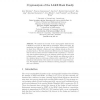Free Online Productivity Tools
i2Speak
i2Symbol
i2OCR
iTex2Img
iWeb2Print
iWeb2Shot
i2Type
iPdf2Split
iPdf2Merge
i2Bopomofo
i2Arabic
i2Style
i2Image
i2PDF
iLatex2Rtf
Sci2ools
FSE
2009
Springer
2009
Springer
Cryptanalysis of the LAKE Hash Family
We analyse the security of the cryptographic hash function LAKE-256 proposed at FSE 2008 by Aumasson, Meier and Phan. By exploiting non-injectivity of some of the building primitives of LAKE, we show three different collision and near-collision attacks on the compression function. The first attack uses differences in the chaining values and the block counter and finds collisions with complexity 233 . The second attack utilizes differences in the chaining values and salt and yields collisions with complexity 242 . The final attack uses differences only in the chaining values to yield near-collisions with complexity 299 . All our attacks are independent of the number of rounds in the compression function. We illustrate the first two attacks by showing examples of collisions and near-collisions.
| Added | 04 Sep 2010 |
| Updated | 04 Sep 2010 |
| Type | Conference |
| Year | 2009 |
| Where | FSE |
| Authors | Alex Biryukov, Praveen Gauravaram, Jian Guo, Dmitry Khovratovich, San Ling, Krystian Matusiewicz, Ivica Nikolic, Josef Pieprzyk, Huaxiong Wang |
Comments (0)

